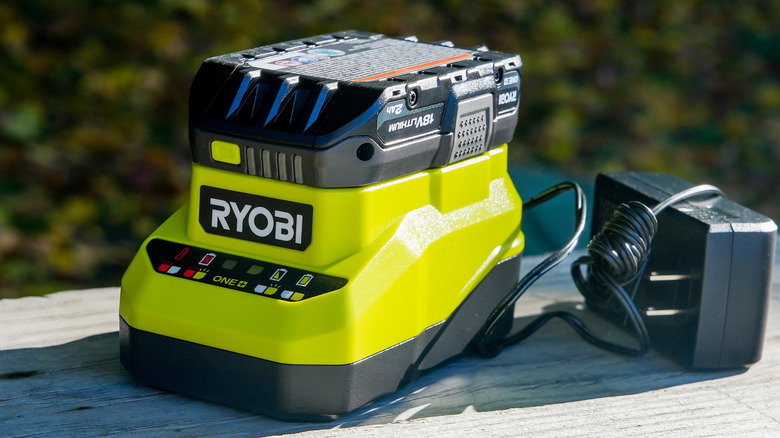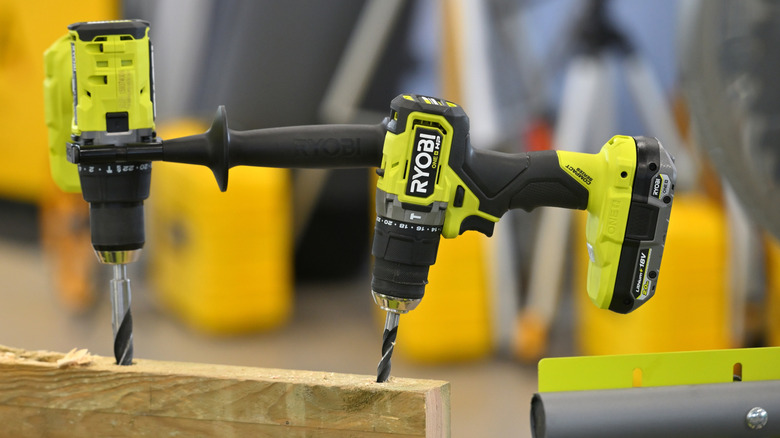How To Determine If Your Ryobi Battery Is Overheating And How To Cool It Down Safely
It's a self-evident truth that the worst battery behavior is when you're using a tool steadily, working hard, and it suddenly stops working. And that circumstance can usually be summed up in one hideously unpleasant fact of life with lithium-ion batteries ... overheating. Most tool batteries have their challenges with overheating, and Ryobi's One+ battery platform is no exception.
Battery overheating can be caused by a number of factors, including using a tool continuously in abnormally warm circumstances or using a tool beyond its rated load. One of the quickest and most potentially damaging causes of overheating is when a tool stalls during an operation, as when a bit or blade gets stuck, but the motor continues to attempt to move it. This causes the motor to draw an extreme amount of current, called "stall current," that — coupled with the low internal resistance of a motor — effectively behaves like a short circuit, producing a great deal of heat very quickly. This level of heat can be damaging to the tool and to the battery and, in fact, can create a dangerous over-temperature situation in lithium-ion batteries that occasionally fail spectacularly in flames as a result of thermal runaway.
How to identify overheating
The easiest way to identify an overheating tool battery is that the tool and/or the battery becomes uncomfortably hot to the touch. You can confirm this with a thermal camera, of course, but if you're familiar with the normal operating temperature of a tool or battery platform, you probably won't have much trouble identifying a hotter-than-normal temperature.
Some Ryobi batteries, notably their 40-volt lithium-ion line, display an error code on the battery's built-in LED indicator lights that warn about over-temperature and other states. The standard Ryobi One+ 18-volt batteries do not appear to have this functionality, or at least Ryobi doesn't feel comfortable promoting it, so users have to rely on battery temperature, behavior, and their chargers to know when a problem has arisen. In general, a Ryobi battery charger produces a flashing red light when a battery is either too hot or has been too deeply discharged.
This overheating business is common to all brands and is one of the key dangers you should know about lithium-ion batteries. It is also why you shouldn't make one common storage mistake; it is, it turns out, a bad idea to store lithium-ion batteries in your garage or un-air-conditioned workshop.
Here's what happens when a battery overheats
Some tools, particularly higher-end tools with brushless motors, have integrated stall detection circuits that cause the tool to shut down when a stall is detected. Tools without stall detection generally rely on thermistors in the battery pack to detect an over-temperature state and shut off the battery in a desperate act of self-protection. It does this by means of the onboard battery management system (BMS), which does all the heavy lifting of making lithium-ion batteries safe from balanced charging to overcharge, overdischarge, and ... you guessed it ... over-temperature protection.
When a battery shuts itself down because of overheating (in Ryobi's case, that means exceeding about 140 degrees Fahrenheit), it normally resumes its duties after cooling down. And, in fact, this waiting period is generally a good idea when anything temperature-related happens to a lithium-powered tool. Normally, the tool returns to full function, but occasionally it does not, and sometimes the overheated battery will not charge even after cooling to room temperature. There are a number of causes for this, from an internal increase in resistance to any number of problems that can be caused by an extreme case of overheating. (One common scenario, for some manufacturers, is that the thermistor breaks away at its solder point, making it impossible for the BMS to receive an "all clear" once temps return to normal.) In a case like this, repairs might be possible but would be extremely dangerous, and you're better off recycling the battery in the manner of your local authorities rather than repairing or refurbishing your dead Ryobi battery.


